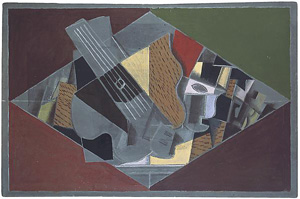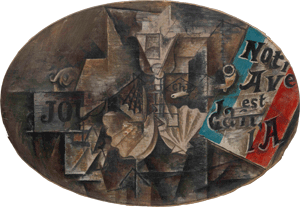The Shape of Painting
John Haberin New York City
Cubism and Trompe l'Oeil
In 1912, Pablo Picasso changed the shape of painting. At the very least, he changed the shape of Cubism, from its strangely fragmented but strangely enduring easel paintings. He took a canvas oval, set it horizontally, and enclosed it in rope as a coarse frame. He had not turned painting upside down, but at the very least he turned it on its side.
A shape so natural to bedroom mirrors and centuries of portraits had become the shape of a breakfast tray. With so tactile a frame, one can imagine holding it one's hands to deliver the morning coffee and the paper. And Picasso really does deliver the news—Le Journal, reduced in the finished painting to just three letters, JOU. If you know your French, "The Daily" has become a deadly "game." First, though, before a drop of oil on canvas, he pasted a piece of oilcloth, covering the oval and darkening Cubism's morning into black. It also bears machine-printed caning. 
As the first collage, Still Life with Chair Caning reinvented Cubism. It bore not just suggestive hints of life, like a pipe in smears of oil, but also the real thing. In the process, Picasso reinvented still life and, for that matter, painting. Had he also reinvented a venerable tradition, trompe l'oeil, or painting to "deceive the eye"? The Metropolitan Museum claims nothing less, with "Cubism and the Trompe l'Oeil Tradition." It sets Picasso, Georges Braque, and Juan Gris beside classic and not so classic paintings from Renaissance Europe through nineteenth-century America.
Sour grapes
Actually, it starts earlier still, with a story. In A.D. 77, Pliny the Elder told of a competition to deceive the eye, as a parable of what makes art great. One artist, he writes, deceived even birds, who pecked at his painted grapes, but he must surrender the prize to a second, who deceives even him. The winner tricks the loser into trying to peel back a fake curtain. Sure enough, three European artists from three countries and from 1500 to the 1660s weigh in with their own painted curtain, birds, and grapes. The rest of the show sees centuries old art as every bit as self-aware and self-reflective as Cubism—and Cubism as every bit as competitive as trompe l'oeil.
Fair enough, and subsequent sections point to shared motifs between Cubism and tradition—like wine bottles, musical instruments, wallpaper, and personal letters. Cornelius Norbertus Gijsbrechts in 1665 paints the tools of his trade as if they had a life of their own. And then he signs the work on a fictive note folded over the fictive palette knife. With Samuel van Hoogstraten, also Flemish, the frame itself is illusory, and a painted note compares him to the winner of Pliny's ancient contest. By far the most vivid trompe l'oeil painter after Jean-Etienne Liotard, William Harnett in 1888, weaves in a book of Irish melodies that his ancestors might have sung and calling cards from his patrons. The show sees the origins of the genre in the 1600s, as just another part Dutch still life, and why should it end with a little oilcloth and chair caning?
Pablo Picasso, for one, was not done with illusion. He just tore it into pieces and put the onus on machine printing. George Braque, whose father and grandfather were house painters, added fake-wood grain to his Homage to J S Bach. He drew on his training as a decorator, with a decorator's comb as his tools. And then he dares you to decide which mind game is which. Picasso and Juan Gris even painted grapes.
Still, call me dubious. The Met has a way of throwing its indisputable clout behind controversial attributions. It has a bad habit, too, of using public exhibitions to rewrite scholarly art history. It has done so more than once with the Northern Renaissance, and it does so again with artists who might not have liked each other one bit. As curators, Emily Braun of New York's City University and Elizabeth Cowling of the University of Edinburgh, deserve credit for recovering past art and modern parallels. Yet their theme will come as a surprise not just to admirers of modern art, but to traditionalists as well.
Modern art still shocks, like Picasso's masks, because it seems to many to have abandoned illusion. Why, people still ask, have artists lost the talent for painting what they see? Tom Wolfe got a best-seller out of calling Andy Warhol and the like a fraud. Blockbuster crowds flock to Edward Hopper, but the demand for the familiar never ends, and not even René Magritte can satisfy it. One of my parents loves the story of cabbies stopping for a sculpture of a man hailing a cab, by J. Seward Johnson. It sounds suspiciously like the story of birds pecking at grapes.
Was either story ever justified? Every illusion tells a story, and I have trouble thinking of birds as sharing the visual and narrative habits of people. A driver that stopped for sculpture had to have been moving too quickly to see more than an upraised arm. In any case, the driver overlooked the sculpture's dark bronze finish. These are dark days for driving a cab—or for a naïve, pedestrian realism. And that is precisely why modern art went its own way.
Taking flight
If art depends on one thing, it is looking, and both traditions are all about paying attention. By the same token, the last thing art needs is effacing difference, not even in the cause of illusion. Cubism was not just multiplying fictions, but dismantling them—and then asking what is left. As the curators themselves say, it was raising "questions about originality, truth, and falsehood." A past artist might have juxtaposed a reproduction with his painted copy, daring you to tell which is which. Gris includes an engraving after J. M. W. Turner, daring you to see it as a reproduction.
Did that itself efface difference—the difference between truth and a lie? Only if Modernism's or Postmodernism's questions will go away. In turn, it asked to see more in painting. Picasso made quite a leap in introducing collage—what textbooks call the difference between Analytic and Synthetic Cubism. One can see its legacy in everything from Dada to a Robert Rauschenberg combine painting to appropriation today. Still, he was always looking, and that might well mean effacing difference, but differences he could no longer abide.
First, Cubism had those mechanical means of illusion, not boasting of an artist's facility but questioning it. Fake news today perpetuates illusions, but back then newsprint could simulate wood grain, too. Second, Cubism broadened the whole idea of illusion, to unnerve the primacy of vision. A painting could evoke not just an object, but its shape, its color, its sensation to the hand, its aroma, and its sound—and could treat each of them separately, as wisps of reality within a painting. Painting now had its silent music, lingering in the mind long after the sound has died. Braque has his unmatched warmth, in those shades of wood, Gris the chill blues of a long Parisian night.
In these ways, Cubism multiples and disassembles illusion. You may read that Cubism brings together different points of view, but it is not a mirror or a film strip. It has those varieties of sensation,  and it has its inconsistent modeling and its fragments. Earlier artists had grown fond of simulated letter racks, but Gris reduces even these to their traces. The show has separate sections for still life on a table and on the wall, but Cubism looks down on the table, reducing it to a painted surface as well. As for the wall, somehow it includes a glass and fruit dish, suspended in space.
and it has its inconsistent modeling and its fragments. Earlier artists had grown fond of simulated letter racks, but Gris reduces even these to their traces. The show has separate sections for still life on a table and on the wall, but Cubism looks down on the table, reducing it to a painted surface as well. As for the wall, somehow it includes a glass and fruit dish, suspended in space.
The show proceeds by subject matter. Often as not, that means squeezing Cubism into traditional categories it could not have known. Picasso's absinthe glass enters a section for paragone, or the competition between painting and sculpture—including its painted sugar cube and found metal spoon. Plays on newspapers, reproductions, and notes become the obscure papyrophilia, or love of papers. One section introduces printed wallpaper from the French Empire, and another gives due attention to typography. And yet chronology and the development of Cubism are cast to the winds.
No wonder the show can then claim a trompe l'oeil tradition, still apparent in still life today. And that runs a still greater risk, of diminishing Cubism by assimilating it to old messages and second-rate art. You are unlikely to recognize most of the names here—and those painted grapes on the way in will fool no one. A final section says it all, "The Artist Is Present," even as Cubism questioned presence and absence. When the no longer young Picasso painted Notre Avenir Est dan l'Air, after a Michelin tire ad, he anticipated Pop Art, with its love-hate relationship with consumer culture. Yet the future really was up in the air, and art had taken flight.

"Cubism and the Trompe l'Oeil Tradition" ran at The Metropolitan Museum of Art through January 22, 2023.




